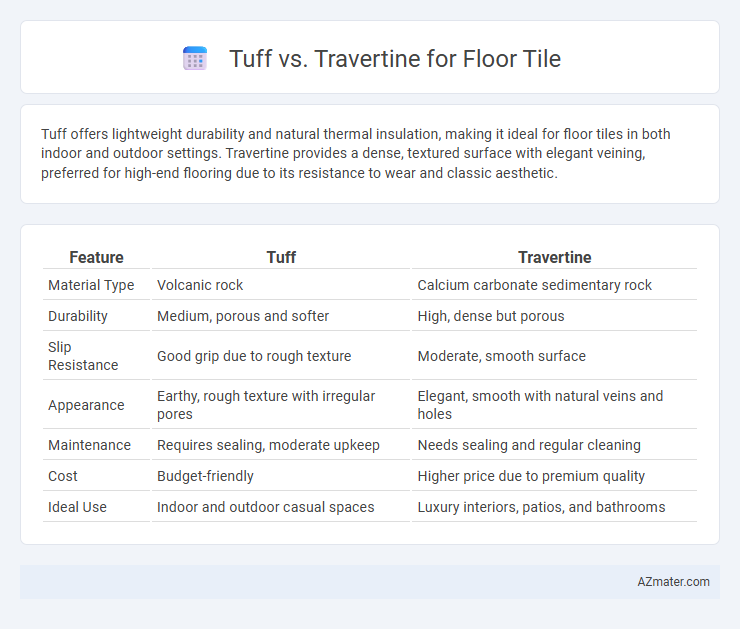Tuff offers lightweight durability and natural thermal insulation, making it ideal for floor tiles in both indoor and outdoor settings. Travertine provides a dense, textured surface with elegant veining, preferred for high-end flooring due to its resistance to wear and classic aesthetic.
Table of Comparison
| Feature | Tuff | Travertine |
|---|---|---|
| Material Type | Volcanic rock | Calcium carbonate sedimentary rock |
| Durability | Medium, porous and softer | High, dense but porous |
| Slip Resistance | Good grip due to rough texture | Moderate, smooth surface |
| Appearance | Earthy, rough texture with irregular pores | Elegant, smooth with natural veins and holes |
| Maintenance | Requires sealing, moderate upkeep | Needs sealing and regular cleaning |
| Cost | Budget-friendly | Higher price due to premium quality |
| Ideal Use | Indoor and outdoor casual spaces | Luxury interiors, patios, and bathrooms |
Introduction to Tuff and Travertine Tile
Tuff and travertine tiles are both natural stone options known for their distinct textures and durability in flooring applications. Tuff, a lightweight volcanic rock, offers a porous surface that enhances slip resistance while providing a rustic aesthetic ideal for outdoor and indoor use. Travertine, a sedimentary limestone characterized by its natural pits and veins, delivers a classic, elegant look with excellent durability and easy maintenance, making it a popular choice for high-traffic residential and commercial flooring.
Geological Formation and Composition
Tuff is a volcanic rock formed from consolidated volcanic ash and debris, primarily composed of fragments of volcanic glass, minerals, and crystals, resulting in a porous and lightweight texture suitable for flooring with natural insulation properties. Travertine is a sedimentary rock formed through the rapid precipitation of calcium carbonate in mineral-rich hot springs or limestone caves, characterized by its dense, fibrous or concentric banded structure, making it durable and ideal for decorative floor tiles. The geological formation of tuff contributes to its softer, more absorbent nature, whereas travertine's mineral composition provides enhanced hardness and resistance, influencing their respective performance as floor tile materials.
Appearance and Aesthetic Differences
Tuff floor tiles exhibit a unique porous texture with muted earth tones, offering a rustic, natural aesthetic that enhances organic and contemporary designs. Travertine tiles feature a distinctive smooth surface with pronounced veins and a wide range of warm shades, providing a classic and elegant look favored in traditional and Mediterranean interiors. The contrast in texture and color variation between Tuff's rugged matte finish and Travertine's polished glossy appearance defines their distinct visual appeal in flooring applications.
Durability and Hardness Comparison
Tuff, a volcanic rock, features moderate hardness ranging from 3 to 4 on the Mohs scale, making it less durable compared to travertine, which typically rates between 6 and 7. Travertine's higher density and resistance to scratches and impact contribute to its superior durability for floor tile applications. While tuff offers a unique porous texture, travertine's hardness ensures longer-lasting performance in high-traffic areas.
Porosity and Water Absorption
Travertine exhibits high porosity with natural pits and voids, resulting in water absorption rates typically between 2% and 10%, which necessitates sealing to prevent stains and moisture damage. Tuff, a less porous volcanic rock, generally has lower water absorption rates around 1% to 3%, offering better resistance to moisture without frequent sealing. This significant difference in porosity impacts durability and maintenance, making Tuff more suitable for wet or high-traffic areas compared to Travertine floor tile.
Maintenance and Cleaning Requirements
Tuff floor tiles require minimal maintenance due to their dense, non-porous composition, which resists stains and moisture effectively. Travertine tiles demand regular sealing and gentle cleaning with pH-neutral products to prevent staining and surface etching caused by their porous nature. Both materials benefit from routine sweeping and prompt spill cleanup, but travertine's upkeep is more intensive to maintain its natural beauty and durability.
Slip Resistance and Safety Considerations
Tuff floor tiles offer superior slip resistance due to their textured, non-porous surface, making them ideal for high-traffic and wet areas. Travertine tiles, while visually appealing with natural stone patterns, tend to be more porous and require sealing to enhance slip resistance and prevent surface wear. Prioritizing safety, Tuff tiles provide a more reliable grip underfoot, reducing the risk of slips and falls in both residential and commercial applications.
Cost and Price Comparison
Tuff floor tiles typically cost between $3 to $6 per square foot, offering a budget-friendly option compared to travertine, which ranges from $6 to $12 per square foot due to its natural stone quality and more intensive extraction process. Installation costs for tuff are generally lower as it is easier to cut and shape, whereas travertine requires skilled labor to handle its porous surface and avoid damage. Overall, tuff presents a cost-effective solution with moderate durability, while travertine commands a premium price reflecting its aesthetic appeal and long-lasting resilience.
Environmental Impact and Sustainability
Tuff tiles, derived from volcanic ash, offer superior environmental benefits due to their natural formation and minimal processing requirements, resulting in lower carbon emissions compared to travertine. Travertine, a sedimentary limestone, involves quarrying processes that significantly disrupt ecosystems and generate more waste, raising concerns about long-term sustainability. Choosing tuff promotes eco-friendly flooring solutions by reducing habitat destruction and supporting sustainable material sourcing practices.
Best Applications: Where to Use Tuff vs Travertine
Tuff is ideal for outdoor applications such as garden pathways, patios, and facades due to its porous nature and weather resistance. Travertine excels in indoor spaces like bathrooms, kitchens, and living rooms, offering a polished, elegant surface that withstands moderate foot traffic. Selecting Tuff for rugged, natural environments and Travertine for refined, decorative interiors ensures durability and aesthetic harmony in floor tile choices.

Infographic: Tuff vs Travertine for Floor Tile
 azmater.com
azmater.com